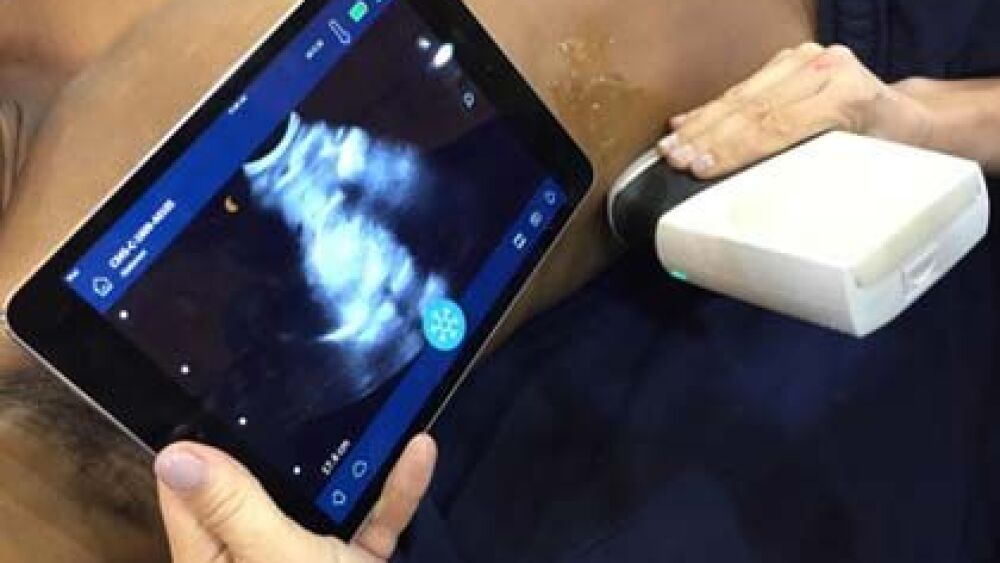NEW ORLEANS — The implementation and use of prehospital ultrasound is a technology with the potential to transform prehospital care. Howie Mell, MD, defined ultrasound and its uses in an education session at the EMS World Expo.
Mell is an emergency physician and medical director for a county EMS system in North Carolina. As an early adopter of prehospital ultrasound, Mell described the implementation of prehospital ultrasound, using the Terason 3200T, into the system and its protocols for use, his agency’s protocols for use and the future of this important imaging technique in EMS.
In an energetic and informative presentation, Mell also discussed ultrasound technology, future applications and challenges to using ultrasound. Mell believes that despite significant implementation challenges prehospital ultrasound imaging will allow hospitals to better prepare to receive critically ill and injured patients.
Memorable quotes on implementing prehospital ultrasound
Here are memorable quotes from Mell on prehospital ultrasound.
“This is the next generation. What we will be doing. What we have to do to provide better information. The way we will transform EMS is getting better information to people who need it when they need it.”
“When you are first implementing ultrasound, trying to learn ultrasound on your iPhone screen will be difficult.”
“Ultrasound is the next 12-lead. It is the next piece of vital information you can provide to the hospital about your patient.”
Key takeaways on prehospital ultrasound
Ultrasound provides important information to help paramedics inform hospitals on the important resources to allocate for incoming trauma and medical patients. Here are the key takeaways from Mell’s presentation on implementation and use of ultrasound for prehospital providers.
Understand the basics of ultrasound
Ultrasound displays the signal as soundwaves bounce off structures in the body. The transducer sends soundwaves and detects the reverberation. A computer analyzes and displays the images on a screen. Different transducers — linear, curvilinear and phased array — serve different functions. Ultrasound, like a 12-lead ECG, doesn’t replace other assessments. It enhances assessments and the need to provide treatment.
Mell’s paramedics completed a 12-hour training program with a classroom and live model imaging components. The training concluded with a 50 image test which had 10 positive studies and 40 normal images. Every student scored 91 percent or better.
3 prehospital ultrasound uses
Mell’s service has an ultrasound in each supervisor’s vehicle and the medical director vehicle. Mell described three primary uses of ultrasound.
1. Trauma patient. An eFAST exam, which is an extended focused assessment with sonography for trauma, to look into the abdominal and chest cavity for internal hemorrhage on patients with unstable vital signs. The exam looks for bleeding in five locations — around the kidney, liver, spleen, heart and lungs. Mell described ultrasound as more accurate at detecting a pneumothorax than a chest X-ray.
2. Pregnancy. For any obtunded patient of child bearing years, ultrasound can be used to assess for pregnancy. The paramedic’s role is to simply identify the presence of a fetus and to notify the trauma center that the patient is pregnant.
3. CPR cessation. Mell’s paramedics use ultrasound to assess cardiac motion to guide resuscitation efforts in medical and traumatic arrests. Ultrasound, combined with capnography findings and lack of mechanical activity, confirms cessation of resuscitation efforts.
Other prehospital ultrasound uses
Ultrasound can be used to guide intravenous line and chest tube placement. It also has the potential to identify shock, as well as gall bladder and appendix inflammation. During tactical triage, when there are large number of critically injured patients, ultrasound could be used to image for the presence or absence of cardiac activity.
Learn more:
- Prehospital Ultrasound: Emerging technology for EMS
- Inside EMS Podcast: Is prehospital ultrasound the next big thing in EMS care?
- Ind. paramedics equipped with portable ultrasound
- Tension pneumothorax: How capnography and ultrasound can improve care
Top Tweets:
LIVE on #Periscope: #EMSWorldExpo #EMSPOCUS https://t.co/YR48cpjWo9
— Dr. Howie Mell (@DrHowieMell) October 6, 2016
Sharing welcome by @DrHowieMell #EMSWorldExpo pic.twitter.com/joIqyw7bc7
— EMS1 (@EMS1) October 6, 2016
“EMS ultrasound is the new 12 lead” @DrHowieMell #EMSWorldExpo pic.twitter.com/Ue1zHkXUJp
— Thomas Beers (@Fire_Leadership) October 6, 2016













